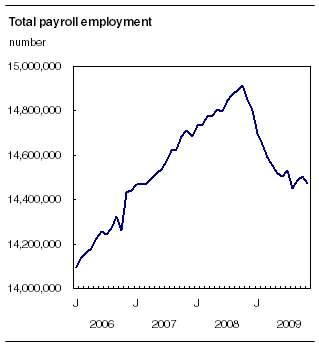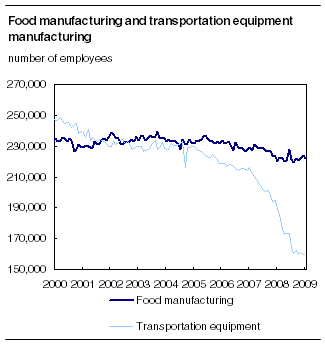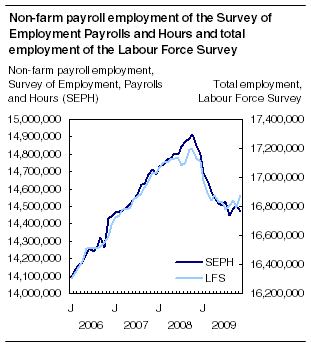Common menu bar links
Payroll employment, earnings and hours
Archived Content
Information identified as archived is provided for reference, research or recordkeeping purposes. It is not subject to the Government of Canada Web Standards and has not been altered or updated since it was archived. Please "contact us" to request a format other than those available.
Related subjects
Non-farm payroll employment fell by 33,800 in November, the result of small losses across a large number of industries. This decline followed two consecutive months of increases.
Since June 2009, the trend in payroll employment has been relatively flat, compared with the first six months of the year when it declined sharply. This change in trend reflects a slower pace of loss in some industries, combined with little change or growth in other industries since June.

The largest losses in November were in grocery stores (-4,100); other provincial and territorial public administration (-3,400); universities (-2,900); wired telecommunications carriers (-2,800); and pulp, paper and paperboard mills (-2,200).
There were also increases in payroll employment in some industries in November, including community care facilities for the elderly (+3,100); computer systems design and related services (+2,500); non-depository credit intermediation, which includes credit card and sales financing issuers (+2,300); and couriers (+2,200).
Shifting trend in payroll employment in many industries
Since June, the pace of job losses in manufacturing has slowed considerably to 6,100 per month on average. This was the largest turnaround of all industries. From October 2008 to June 2009, manufacturing had shed over 21,600 jobs per month on average. Among manufacturing industries still experiencing job losses, albeit at a slower pace, are plastic products; architectural and structural metals; and sawmills and wood preservation.
Note to readers
These data come from the Survey of Employment, Payrolls and Hours (SEPH). SEPH is a business survey that provides a detailed portrait of employees by industry. It complements information from the Labour Force Survey (LFS), which is a household survey.
Estimates of employment, wages and hours derived from these two surveys differ for a number of reasons.
First, the reference periods are different. LFS data are collected during a "reference week," usually the week following the 15th of the month. For SEPH, the reference period is an entire month.
The LFS includes people who are self-employed, as well as workers who take unpaid leave. SEPH does not cover these groups. Industry coverage for the LFS is comprehensive; SEPH excludes agriculture, fishing and trapping, and religious organizations.
The two count multiple job holders differently. In the LFS, people with more than one job are counted only once as "employed." SEPH is a count of filled positions on payroll, so each job is counted separately.
Finally, national estimates produced by the LFS do not include people living in the three territories or on reserves, while those produced by SEPH do. LFS estimates are based on where people usually reside. SEPH counts employees in the province or territory where they work, although this has little effect on comparability at the national level.
While some manufacturing industries have experienced a slower pace of job loss, others have seen gains since June. Both motor vehicle parts manufacturing and motor vehicle assembly incurred steep job declines after October 2008. However, since June 2009, these industries have added employees, with motor vehicle assembly up 3,600 and motor vehicle parts up 1,300.
Since June 2009, the construction sector has been adding jobs (+13,700 or +1.7%). During the first eight months of the economic downturn, it had been shedding jobs. Other industries with ties to construction, such as architectural, engineering and related services; building material and garden equipment and supplies dealers; and veneer, plywood and engineered wood product manufacturing have also shown stabilization or moderate job growth since June.
Health care and social assistance, public administration, finance and insurance, and education continued to grow throughout the economic downturn.
Food manufacturing is top employer in manufacturing sector
While comparable with the transportation equipment manufacturing sector for many years, the food manufacturing industry is now the largest employer in the manufacturing sector. In November, there were 222,300 employees in food manufacturing, compared with 159,100 in transportation equipment.

The gap between food and transportation equipment manufacturing has increased since the peak of payroll employment in October 2008. While the number of jobs in food manufacturing edged down 0.5%, it dropped 18.3% in transportation equipment manufacturing. In overall manufacturing, the number of payroll jobs decreased 12.4% during this period.
Since June 2009, the number of employees in food manufacturing has risen, underpinned by growth in seafood product manufacturing (+2,300), sugar and confectionary product manufacturing (+1,000), as well as bakeries and tortilla manufacturing (+1,000).
The beverage manufacturing industry has experienced job growth since the peak of payroll employment. Growth in this industry was 5.0% between October 2008 and June 2009. Since then, its pace of growth has accelerated to 10.8% (+2,800).
Slower pace of growth in average weekly earnings
Average weekly earnings, including overtime, of payroll employees was $830.46 in November, up 1.3% from November 2008. Year-over-year growth has continued to hover around this rate since last June. Prior to June, however, year-over-year growth in average weekly earnings, including overtime, had been in the 3% range.
Among Canada's largest industrial sectors, average weekly earnings increased between November 2008 and November 2009 in accommodation and food services (+4.3%), public administration (+4.0%), health care and social assistance (+1.7%), educational services (+1.3%) and retail trade (+0.8%).
Over the same period, average weekly earnings declined in both manufacturing (-1.4%) and construction (-0.9%).
Some of the industries that experienced large drops in payroll employment also saw declines in average weekly earnings between November 2008 and November 2009. Motor vehicle parts manufacturing experienced a year-over-year earnings drop of 11.5%, as did support activities for mining, oil and gas extraction (-4.2%). In contrast, average weekly earnings in motor vehicle assembly increased 7.7% year over year, while payroll employment was down.
All provinces saw their average weekly earnings increase in November compared with November 2008. Newfoundland and Labrador experienced the fastest growth (+4.7%), followed by Prince Edward Island (+4.2%) and Manitoba (+3.8%). British Columbia (+0.3%) had the slowest year-over-year growth.
Comparing the Survey of Employment, Payrolls and Hours and the Labour Force Survey
In November, the number of non-farm payroll jobs, as measured by the Survey of Employment, Payrolls and Hours (SEPH), fell by 33,800 from October. For the same month, the number of employees in all industries, as measured by the Labour Force Survey (LFS), rose 110,000.

Some of this difference can be explained by the fact that SEPH shows payroll employment over the entire month, while LFS reflects labour market conditions for the week that usually includes the 15th of the month (see note).
In November, LFS showed a large increase in education, while SEPH reported an increase for that sector in October, suggesting that some of the hiring could have happened after the LFS reference week in October.
Also in November, LFS reported a rise in the finance, insurance, real estate and leasing sector, similar to the SEPH increase in October for that sector.
Available on CANSIM: tables 281-0023 to 281-0039 and 281-0041 to 281-0046.
Definitions, data sources and methods: survey number 2612.
Detailed industry data, data by size of enterprise based on employment, and other labour market indicators will be available soon in the monthly publication Employment, Earnings and Hours (72-002-X, free).
Data on payroll employment, earnings and hours for December will be released on February 25.
For more information, or to order data, contact Client Services (toll-free 1-866-873-8788; 613-951-4090; labour@statcan.gc.ca). To enquire about the revisions, concepts, methods or data quality of this release, contact Danielle Zietsma (613-951-7118), Labour Statistics Division.
Table 1
| Industry group (North American Industry Classification System) | November 2008 | October 2009r | November 2009p | October to November 2009 | November 2008 to November 2009 |
|---|---|---|---|---|---|
| Seasonally adjusted | |||||
| current dollars | % change | ||||
| Industrial aggregate | 819.87 | 827.02 | 830.46 | 0.4 | 1.3 |
| Forestry, logging and support | 895.14 | 868.15 | 878.57 | 1.2 | -1.9 |
| Mining and quarrying, and oil and gas extraction | 1,555.85 | 1,544.69 | 1,572.20 | 1.8 | 1.1 |
| Utilities | 1,448.05 | 1,570.89 | 1,525.03 | -2.9 | 5.3 |
| Construction | 1,062.46 | 1,056.89 | 1,052.64 | -0.4 | -0.9 |
| Manufacturing | 948.03 | 900.24 | 935.14 | 3.9 | -1.4 |
| Wholesale trade | 962.00 | 991.48 | 987.09 | -0.4 | 2.6 |
| Retail trade | 487.59 | 496.63 | 491.35 | -1.1 | 0.8 |
| Transportation and warehousing | 894.55 | 853.58 | 846.36 | -0.8 | -5.4 |
| Information and cultural industries | 1,031.44 | 1,032.48 | 1,114.03 | 7.9 | 8.0 |
| Finance and insurance | 998.45 | 1,042.36 | 1,037.34 | -0.5 | 3.9 |
| Real estate and rental and leasing | 712.27 | 764.02 | 796.55 | 4.3 | 11.8 |
| Professional, scientific and technical services | 1,114.23 | 1,122.94 | 1,137.44 | 1.3 | 2.1 |
| Management of companies and enterprises | 1,048.87 | 1,181.85 | 1,232.73 | 4.3 | 17.5 |
| Administrative and support, waste management and remediation services | 676.50 | 673.34 | 671.75 | -0.2 | -0.7 |
| Educational services | 880.38 | 902.44 | 892.15 | -1.1 | 1.3 |
| Health care and social assistance | 769.22 | 769.01 | 782.52 | 1.8 | 1.7 |
| Arts, entertainment and recreation | 490.22 | 521.37 | 510.24 | -2.1 | 4.1 |
| Accommodation and food services | 323.85 | 342.26 | 337.92 | -1.3 | 4.3 |
| Other services (excluding public administration) | 658.65 | 687.67 | 676.89 | -1.6 | 2.8 |
| Public administration | 1,040.74 | 1,085.27 | 1,082.36 | -0.3 | 4.0 |
| Provinces and territories | |||||
| Newfoundland and Labrador | 786.96 | 810.24 | 823.79 | 1.7 | 4.7 |
| Prince Edward Island | 665.00 | 703.26 | 692.89 | -1.5 | 4.2 |
| Nova Scotia | 720.53 | 725.88 | 733.10 | 1.0 | 1.7 |
| New Brunswick | 736.99 | 755.11 | 751.11 | -0.5 | 1.9 |
| Quebec | 748.56 | 761.72 | 764.37 | 0.3 | 2.1 |
| Ontario | 847.51 | 852.66 | 856.57 | 0.5 | 1.1 |
| Manitoba | 755.06 | 784.98 | 783.65 | -0.2 | 3.8 |
| Saskatchewan | 805.02 | 813.13 | 816.31 | 0.4 | 1.4 |
| Alberta | 954.05 | 949.74 | 967.00 | 1.8 | 1.4 |
| British Columbia | 796.22 | 802.90 | 798.86 | -0.5 | 0.3 |
| Yukon | 861.20 | 903.81 | 891.85 | -1.3 | 3.6 |
| Northwest Territories¹ | 1,116.64 | 1,151.73 | 1,168.35 | 1.4 | 4.6 |
| Nunavut¹ | 904.19 | 867.73 | 888.45 | 2.4 | -1.7 |
Table 2
| Industry group (North American Industry Classification System) | December 2008 | November 2008 | October 2009r | November 2009p | October to November 2009 | November 2008 to November 2009 | December 2008 to November 2009 |
|---|---|---|---|---|---|---|---|
| Seasonally adjusted | |||||||
| thousands | % change | ||||||
| Industrial aggregate | 14,800.4 | 14,851.6 | 14,504.9 | 14,471.2 | -0.2 | -2.6 | -2.2 |
| Forestry, logging and support | 44.7 | 45.2 | 39.4 | 39.2 | -0.5 | -13.3 | -12.3 |
| Mining and quarrying, and oil and gas extraction | 203.5 | 206.2 | 171.3 | 171.1 | -0.1 | -17.0 | -15.9 |
| Utilities | 122.7 | 120.6 | 116.7 | 116.1 | -0.5 | -3.7 | -5.4 |
| Construction | 817.7 | 834.0 | 799.9 | 798.9 | -0.1 | -4.2 | -2.3 |
| Manufacturing | 1,599.6 | 1,619.2 | 1,452.1 | 1,442.8 | -0.6 | -10.9 | -9.8 |
| Wholesale trade | 753.7 | 759.1 | 721.3 | 720.0 | -0.2 | -5.2 | -4.5 |
| Retail trade | 1,884.0 | 1,900.9 | 1,851.7 | 1,855.7 | 0.2 | -2.4 | -1.5 |
| Transportation and warehousing | 696.7 | 697.6 | 667.6 | 671.9 | 0.6 | -3.7 | -3.6 |
| Information and cultural industries | 326.3 | 325.1 | 316.1 | 313.2 | -0.9 | -3.7 | -4.0 |
| Finance and insurance | 666.4 | 669.6 | 683.8 | 686.6 | 0.4 | 2.5 | 3.0 |
| Real estate and rental and leasing | 246.8 | 249.8 | 241.5 | 241.7 | 0.1 | -3.2 | -2.1 |
| Professional, scientific and technical services | 766.6 | 767.5 | 731.8 | 739.6 | 1.1 | -3.6 | -3.5 |
| Management of companies and enterprises | 121.3 | 122.3 | 115.3 | 116.5 | 1.0 | -4.7 | -4.0 |
| Administrative and support, waste management and remediation services | 754.2 | 760.9 | 714.7 | 713.1 | -0.2 | -6.3 | -5.4 |
| Educational services | 1,147.5 | 1,144.3 | 1,151.9 | 1,147.3 | -0.4 | 0.3 | 0.0 |
| Health care and social assistance | 1,567.2 | 1,547.1 | 1,595.3 | 1,599.0 | 0.2 | 3.4 | 2.0 |
| Arts, entertainment and recreation | 242.1 | 244.7 | 250.2 | 248.0 | -0.9 | 1.3 | 2.4 |
| Accommodation and food services | 1,095.3 | 1,087.9 | 1,063.3 | 1,065.8 | 0.2 | -2.0 | -2.7 |
| Other services (excluding public administration) | 510.5 | 508.8 | 504.6 | 504.6 | 0.0 | -0.8 | -1.2 |
| Public administration | 1,024.4 | 1,021.2 | 1,054.0 | 1,055.3 | 0.1 | 3.3 | 3.0 |
| Provinces and territories | |||||||
| Newfoundland and Labrador | 192.4 | 193.2 | 193.4 | 193.5 | 0.1 | 0.2 | 0.6 |
| Prince Edward Island | 61.5 | 61.6 | 63.1 | 62.6 | -0.8 | 1.6 | 1.8 |
| Nova Scotia | 393.0 | 395.3 | 391.9 | 390.1 | -0.5 | -1.3 | -0.7 |
| New Brunswick | 311.0 | 311.9 | 310.4 | 309.3 | -0.4 | -0.8 | -0.5 |
| Quebec | 3,393.1 | 3,400.6 | 3,373.7 | 3,367.3 | -0.2 | -1.0 | -0.8 |
| Ontario | 5,671.0 | 5,685.5 | 5,561.1 | 5,555.2 | -0.1 | -2.3 | -2.0 |
| Manitoba | 562.8 | 565.2 | 552.8 | 552.1 | -0.1 | -2.3 | -1.9 |
| Saskatchewan | 439.9 | 439.2 | 439.0 | 439.9 | 0.2 | 0.2 | 0.0 |
| Alberta | 1,789.8 | 1,799.6 | 1,713.0 | 1,708.9 | -0.2 | -5.0 | -4.5 |
| British Columbia | 1,935.0 | 1,945.6 | 1,873.1 | 1,865.5 | -0.4 | -4.1 | -3.6 |
| Yukon | 19.5 | 19.3 | 19.1 | 19.1 | 0.0 | -1.0 | -2.1 |
| Northwest Territories¹ | 26.8 | 27.2 | 27.1 | 26.2 | -3.3 | -3.7 | -2.2 |
| Nunavut¹ | 10.1 | 10.2 | 11.1 | 10.8 | -2.7 | 5.9 | 6.9 |

